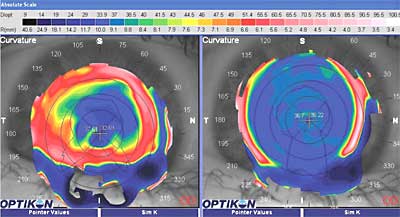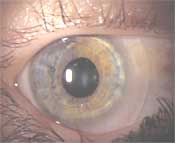Study: Contacts fit over intrastromal corneal ring segments for post-LASIK ectasia
Contact Lenses and Eyewear
The use of intracorneal ring segments has been shown to improve visual acuity in patients with mild myopia, keratoconus and post-LASIK ectasia, according to Mitra E. Mehin, OD, FAAO, and David J. Schanzlin, MD. For those with unsatisfactory uncorrected visual acuity after ICRS implantation, the researchers found in their study that hybrid and soft contact lenses provided a successful fit and improved vision, correcting irregular corneal astigmatism.
Irregular astigmatism and corneal elevation at the site of the ICRS can make fitting contacts challenging in these corneas, according to the researchers’ poster on the study. However, some patients do not want to use spectacles for this residual correction.
|
Images: Shanzlin DJ |
Study objective
Prior studies have evaluated the use of contact lenses in patients who were treated with ICRS for keratoconus. The objective of this study was to report experiences fitting post-LASIK ectasia patients who had poor uncorrected visual acuity with contact lenses.
Drs. Mehin and Schanzlin retrospectively studied six eyes of six patients treated with ICRS for LASIK-induced keratectasia. Two of the six eyes had undergone previous radial keratotomy and the remaining four had undergone previous LASIK enhancement surgery.
According to the study poster, each eye had two corneal ring segments present. In one eye inserts were positioned vertically through an incision at 90°, in two eyes they were positioned horizontally through an incision at 180°, and in three eyes inserts were positioned at about an axis of 150°.
|
|
Five of the patients were fit with contact lenses within the first 6 weeks after ICRS implantation. One patient was fit 8 months after the procedure. The mean manifest cylinder for all eyes was 4.58±0.07 D, according to the poster. Between two and four trial lenses were required for successful fitting.
Study results
All six patients in this series were successfully fit with either a hybrid or soft contact lens. Two eyes were fit with disposable torics and one was fit with a daily wear toric (CooperVision Frequency 55 Toric, Bausch & Lomb SofLens 66 Toric and Ocular Sciences Sunsoft Toric); two eyes were fit with a hybrid lens (SynergEyes A and PS); and one was fit with a soft reverse geometry lens (Super Nova RevEyes by Innovations in Sight). The mean spherical equivalent lens power was 1.20±2.79 D, and the contact lens base curves ranged from 8.3 to 9.1.
Patients had a mean uncorrected acuity of less than 20/200. With spectacle correction, acuity improved to better than 20/40, a gain of seven lines. With contact lens correction, it improved to better than 20/30, a gain of eight lines.
This study was presented at Optometry’s Meeting, the annual American Association Congress in Las Vegas.
For more information:
- David J. Schanzlin, MD, and Mitra E. Mehin, OD, FAAO, can be reached at UCSD, Shiley Eye Center, 9415 Campus Point Dr., La Jolla, CA 92093; (858) 822-1553; fax: (858) 822-1514; www.shileylasik.com. Dr. Mehin can be reached at mmehin@cornea.ucsd.edu. Drs. Schanzlin and Mehin have no direct financial interest in the products mentioned in this article, nor are they paid consultants for any companies mentioned.
Reference:
- Mehin E, Schanzlin DJ. The feasibility of contact lens fitting on post-LASIK ectasia pateints with intracorneal ring segments (ICRS). Presented at Optometrys Meeting, the annual AOA Congress; June 21-25, 2006; Las Vegas.


